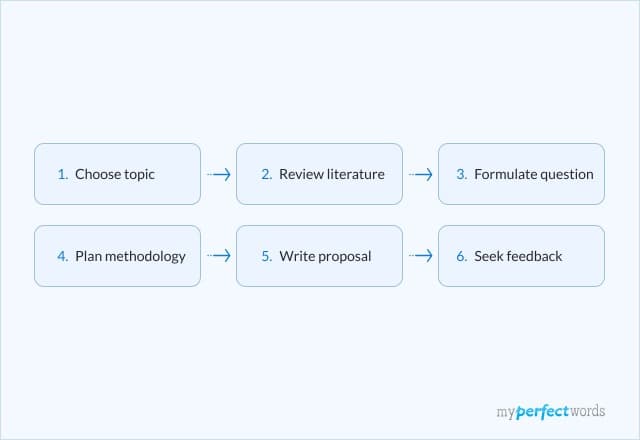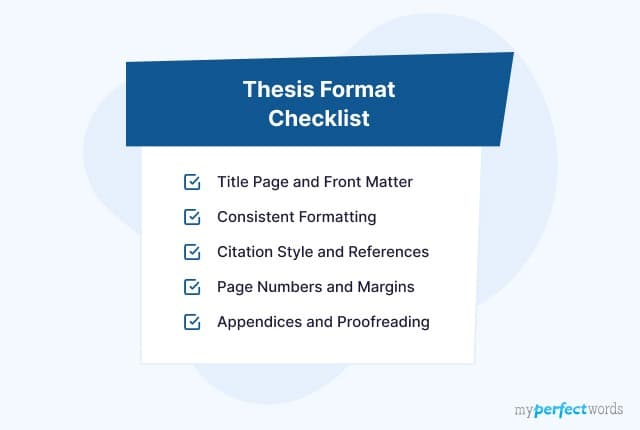

You're staring at a blinking cursor, trying to figure out where to start your introduction for your thesis writing.
It's hard to know where to start, and even harder to keep your introduction engaging and on-topic.
We've written this guide that will take you step-by-step through the process of writing an amazing introduction. You'll also find examples of introductions for different types of papers.
So let's get started!
On This Page![]()
- 1. What is a Thesis Introduction?
- 2. Components of Thesis Introduction
- 3. Thesis Introduction Outline
- 4. How to Start a Thesis Introduction?
- 5. How to Write a Thesis Introduction?
- 6. Thesis Introduction Examples
- 7. Thesis Introduction Writing Tips
- 8. Introduction Writing Checklist
What is a Thesis Introduction?
A thesis introduction is the opening section of a research paper or thesis writing that serves as a roadmap for the entire study.
It provides context and background information for the research topic. The introduction outlines the study's purpose, problem statement, and methodology.
It engages readers, captures their interest, and sets expectations for the rest of the paper.
Importance of Writing a Good Thesis Introduction
Let’s see why a good introduction is important in thesis writing:
- First Impressions: The introduction is your first opportunity to make a positive impression on readers. It's crucial in piquing their interest.
- Contextual Understanding: It offers the necessary background information, ensuring that readers comprehend the research's significance and relevance.
- Problem Statement: The introduction presents the research problem, outlining what the study aims to address, and emphasizing its importance.
- Clarity: A well-structured introduction enhances the clarity of your work, making it easier for readers to follow your thesis.
- Guidance: It serves as a guide for the reader, providing a clear path of what to expect throughout the research, including the methodology and expected outcomes.
How Long is a Thesis Introduction?
The introduction of your thesis paper makes up roughly 10% of your total word count. Therefore, a PhD thesis paper introduction would be 8000 - 10000 words. However, a Master's thesis would be 1500 - 2000 words long.
Although the thesis introduction length can be increased if the writer includes images, diagrams, and descriptions.
Components of Thesis Introduction
The thesis introduction format comprises several essential components that collectively set the stage for your research. These components include:
- Hook or Attention-Grabber
- Background Information
- Problem Statement
- Purpose of the Study
- Significance of the Research
- Overview of the Methodology
Thesis Introduction Outline
A thesis introduction chapter structure contains the following sections:
Have a look at the following thesis introduction template to understand the outline.
How to Start a Thesis Introduction?
Starting a thesis introduction can be overwhelming, but there are some steps you can follow to make it easier:
- Choose a Topic
Select a topic that you are passionate about and that aligns with your research interests. Your topic should also be relevant to your field of study and have enough existing research to support your thesis.
You can also choose unique ideas from our compiled list of thesis topics. - Research the Content
Conduct thorough research on your topic by reviewing the literature, collecting data, and analyzing existing research in your field. This will help you identify gaps in the literature that your thesis will address. - Organize the Ideas
Organize and compile the main arguments, ideas, and claims in the next step. These thoughts will be helpful to describe and present the thesis statement.
Logically organizing your thoughts is crucial for developing an effective and coherent paper. You can create a clear story from the start of your paper to the end. Also, include a table of contents at the beginning of your thesis. It serves as a mind map to discuss the layout of your research proposal. - Define the Subject and Relevant Themes
Define the subject and the relevant themes before starting your thesis introduction.
The subject of a thesis is the central topic or idea that it addresses. It should be specific enough to be covered by the scope of the thesis, yet broad enough to allow for meaningful discussion.
Relevant themes are those ideas that are most applicable to the subject of the thesis. These themes often come from other fields and add depth to the argument being made in the thesis.
This way it would be easier for the reader to skim and get a good idea by going through it. - Define Your Thesis Statement
Once you have conducted your research, define your thesis statement. Your thesis statement should clearly articulate the main argument or point you will be making in your thesis.
Check out this video to learn more about writing a good introduction for your thesis!
How to Write a Thesis Introduction?
Once you are done with the prewriting steps discussed above, you are now ready to dive into actual writing. Here is a step-by-step guide for you to follow while writing a thesis introduction.

A detailed description of the steps to write an introduction is given below.
Step 1: Hook the Reader’s Interest
A writer should begin writing the introduction with a hook statement to draw the reader’s interest. It can be a question, quotation, or interesting transitions into your arguments.
Also, make a list of interesting, current events or controversies related to your topic. It will help in creating a strong introduction and thesis statement.
Step 2: Mention the Research Gap
Review and evaluate the existing literature critically. It will help the researcher in finding and addressing the research gap.
Step 3: State the Background Information
A good introduction to the thesis always states the historical background of the chosen topic. It is usually cited in the first paragraph and shows the current position of the subject.
Step 4: Back Your Topic with Relevant Literature
The introduction is a mix of previous research and a literature review. Thus, the topic should be backed with relevant resources.
It is also used to explain the context and significance of previous studies. Moreover, it further acknowledges credible sources of information to solidify your claim.
When choosing relevant literature, there are a few things to consider.
- Firstly, the literature should be from reputable sources such as scholarly journals or books.
- Secondly, it should be related to your topic and provide evidence for your claims.
- Lastly, it should be up-to-date and accurate.
By taking these factors into account, you can ensure that your work is well-informed and credible.
Step 5: Mention the Hypothesis
Formulate a hypothesis for your research work. It will discuss what you aim to achieve along with the possibilities.
A valid hypothesis must be testable, measurable, and based on evidence from existing literature or theoretical frameworks.
The hypothesis should also provide a logical explanation for the relationship between the variables in question.
Step 6: Provide Significance of Your Research
The gap will help to evaluate the situation and explain the significance of the current research. Thus, add the purpose of your paper explaining why the research is done. It will also demonstrate the possible contributions of the research work in the future.
Step 7: Outline the Research Questions
The next step is to outline your research questions. These should be relevant to the purpose of your study. Moreover, it will also help you discuss the problems that you seek to address.
Step 8: State Research Objectives
State the research aims and objectives to define the primary purpose of the work. It should give a direction to the research by providing an overview of what it aims to achieve.
Step 9: Discuss the Research Methodology
The next step is to define the terms and methodology you are going to apply in your research. It is a good technique to make your study authentic, credible, and useful.
Step 10: Finalize your Introduction
Ask yourself the following questions after finishing writing the introduction.
- Does your introduction discuss the problem your thesis is addressing?
- Does this section address the contribution the research work is making?
- Does it provide a detailed overview of your thesis?
- Does it end by briefly discussing the content of each chapter?
- Does it make a case for the research?
- Does it outline research questions, problems, and hypotheses clearly?
Thesis Introduction Examples
Below are sample thesis introductions to help you compose perfect introductions.
Thesis Introduction Writing Tips
The following are some writing tips to help you draft perfect thesis introductions.
- Highlight the importance of your research early on to engage the reader's interest.
- Introduce the key aspects of the topic to provide context and understanding.
- Craft a dissertation introduction that clearly sets the stage for your research.
- Offer a concise overview of the structure to help the reader navigate your thesis effectively.
- It must follow a coherent thesis format by providing concise information.
- Do not use technical language as it will leave the reader confused.
Introduction Writing Checklist
Use the below checklist to assess your introduction and identify what information is missing. This should help you ensure that your intro has all of the necessary components for a successful outcome.
| Task | Completed |
| Identify the research problem | |
| Write the background of the study | |
| Provide the context of the study | |
| State the research questions | |
| Formulate the objectives and questions | |
| Define key terms and concepts | |
| Discuss the significance of the study | |
| Identify the limitations and scope of your research | |
| Write a brief outline of the thesis | |
| Proofread and edit the introduction |
In conclusion,
Crafting a strong thesis introduction is a crucial element of any academic paper. It sets the tone for your entire paper and provides a roadmap for your reader to follow. By following the steps outlined in this blog post, you can create a well-structured introduction for your thesis.
However, if you are still struggling to write a compelling thesis introduction, don't worry. MyPerfectWords.com is here to help!
With qualified writing experts, we provide the best thesis writing service at student-friendly costs.
So, contact us today to discuss your thesis paper, and let us help you achieve your academic goals.
Moreover, if you are planning to pay somebody to do my essay, look no further. Place your order with us, and you'll get a perfectly crafted essay right on time!

Write Essay Within 60 Seconds!
Use our AI tool to generate high quality essay-18976.png&w=256&q=75&dpl=dpl_932zZQyZ6qqr6Wj2ueuwZpxRi8Mc)
WRITTEN BY
Alexander P.
Harvard Law graduate. I write law essays with the precision and rigor expected at top law schools.




